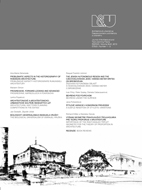ŠTÝLOVÉ VARIÁCIE V KOMORNOM PREVEDENÍ. Rodinné hrobky v diele Michala Milana Harminca
A SUBTLE RENDITION OF STYLISTIC VARIATIONS. Family Mausoleums in the Work of Michal Milan Harminc
Author(s): Jana PohaničováSubject(s): Cultural Essay, Political Essay, Societal Essay
Published by: Historický ústav SAV, v. v. i.
Keywords: Austria-Hungary; sepulchral architecture; Michal Milan Harminc; mausoleum; pragmatic ecclecticism; modernism; Kuffner; Luppa; Mandics
Summary/Abstract: The Kuffner family mausoleum in Sládkovičovo (1926) and the mausoleum in the village of Pomáz near Budapest (1912) are the only realized sepulchral structures from the exceptionally extensive work of M. M. Harminc. Despite their subtle character, they reflect the diversity of their creator’s typological range and stylistic adaptability, in an interesting manner complementing his historicizing motifs which, joined with mondernist elements, lingered well into the 20th century. Present in the background of their creation were several interesting personages, attesting the architect’s connection with prominent patrons, mainly successful businessmen; the cast of characters spans first period of Harminc’s work – the Budapest period, along with pro-Slovak oriented members of the intelligentsia and business circles, as well as patrons of Serbian origin. Information about the two mentioned typologically unique structures of Harminc’s is currently sparse. The on-going research of Harminc’s legacy in the Slovak National Gallery, however, has delivered interesting knowledge based on the yet-unpublished drawings pertaining to these structures. The family mauseoleum in Pomáz dates back to 1912. Chronologically, it can be categorized in the context of works from the Budapest period which falls between 1887 and 1916. The existing scholarly literature does not fully appreciate Harminc’s Budapest period, yet a look into this period’s work portfolio offers a typologically extensive collection of structures of high architectonic quality, especially rich in stylistic variations of historical architectural styles. Predominant are sacral structures, representative buildings of banks and financial institutions, residential architecture – town palaces, villas, apartment buildings, as well as industrial complexes (tanneries), health facilities, museums, schools and sometimes also works of a sepulchral character, which are the current subject of interest. This period’s key realizations in Slovakia include the Evangelical Church of the Augsburg Confession in Prybilina (1901 – 1902), the Church of Our Lady of the Rosary in Černová (1905 – 1907), the Evangelical Church of the Augsburg Confession in Prietrž (1906 – 1907), the Stodola villa in Liptovský Mikuláš (1902 – 1903), two realizations in the town of Martin – the first Slovak National Museum (1906 – 1908) and Tatra banka (1910 – 1911), and a series of realisations for banking institutions with exclusively Slovak capital – the Slovenská banka (Slovak Bank) in Ružomberok (1901 – 1902) and in Trstená (1903), the Ľudová banka (People’s Bank) in Nové Mesto nad Váhom (1904 – 1906) and in Vrbové (1906), and the Slovenská hospodárska banka (Slovak Agricultural Bank), in Trnava (1914). The mausoleum in Pomáz is situated on a mound at the edge of the village, not far from the capital of the Hungarian Empire. It was commissioned by local families, the Luppa or the Mandics family. These names can
Journal: Architektúra & Urbanizmus
- Issue Year: 47/2013
- Issue No: 1-2
- Page Range: 106-121
- Page Count: 16
- Language: Slovak

